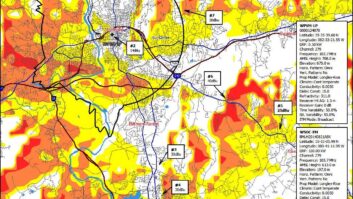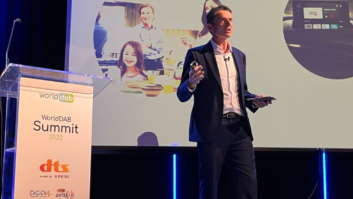I first met Garrison Keillor in that most intimate of settings� on the radio.
Rotary switches, circular dials, analog meters and CRTs: the provenance of the broadcast engineer. They make for a comforting environment even today.

My uncle had given me a Heathkit radio he had built. With a Heathkit, anyone with some free evenings could save money and build really nice equipment. The radio was ahead of its time � allowing the use of AM and FM independently to make up a stereo pair � and the local radio-TV shop sold me a surplus external chassis, four-tube, multiplex stereo decoder that required I leave a diddle-stick in the 19 kHz oscillator coil to periodically tweak it when the stereo image unlocked and began to rotate like the bed-spins in my headphones.
I put a used fringe TV antenna on my parent�s roof that I could climb up and point, searching for the few signals on the FM dial. Stations in the 75-to-150-mile range faded in and out and fluttered when an airplane bisected the path. Stations beyond that range lasted only as long as the duct they were coming though remained, often an hour, sometimes from a thousand miles away.
�Prairie Home Companion� would mature a lot over the decades and leave the lone station of its birth to seemingly follow me as I redeployed farther away with each successive career move. It was a serious concern for me, and a great serendipity, that Keillor�s coverage expanded just as I needed it to. Broadcast gypsies move, but PHC always allowed me to catch up on the news back home. I knew all those people from Lake Woebegone, though their names were different.
PHC was a gift to FM radio as FM struggled for relevance. Any AM station had better numbers than any FM, and my folks didn�t like the tinny sound of FM as much as the warmth of AM. Any old direct tuned AM radio with dynamic speaker has a sound that, if not accurate, is definitely pleasing, even to our now Hi-Fi trained ears.
Keillor retired last year, and I�m maybe not that far behind. There are some signs. The soldering that used to be indistinguishable from machine solder is getting shoddier. The fact that I still think as Bob Pease (a favorite columnist in Electronic Design) said �My favorite programming language is solder� tells you a lot.
My man cave, my happy place, is still the chilly shop in the basement. It has everything, and if it didn�t or doesn�t, I�ll buy it. Proto boards and power supplies use up what space is left of a large collection of parts in little labeled drawers. There are also plenty of tiny embedded things with parts too small to work on. The bench mice and monitors go to a lot of places with a KVM. Forty-feet of data books are slowly being burned for heat, as it really is much easier to look up pinouts and specs on the internet, even for older traditional parts like 555 timers. I keep adding lights and making the old ones brighter. LEDs replace the CFLs that replaced the incandescents that melted plastic placed too close accidentally and burned my fingers when touched. I count six visual magnification devices, the oldest, best and my favorite, was my grandfather�s favorite loupe.
It�s comfortable, but not easy, to grow old in radio. Sometimes I turn on the Ham rig midday on 80-meters (which is all regional propagation during the day). A ham becomes an �Old Man,� the standard greeting between hams since time immemorial, when he gets his �ticket,� even if he is 12-years old. Women remain �Young Ladies� forever on Ham radio. The five-state discussion group covers what we all have in common � memories and health issues.
We are all growing older together. Prairie Home Companion will carry on, and reinvent itself, as will radio. I can�t think of a better profession or obsession to grow in and grow old in than radio.
The Wandering Engineer is an industry stalwart who has been in broadcasting since the days of Marconi and Tesla. He gives his thoughts on the current state of broadcast engineering and the broadcast engineer.












